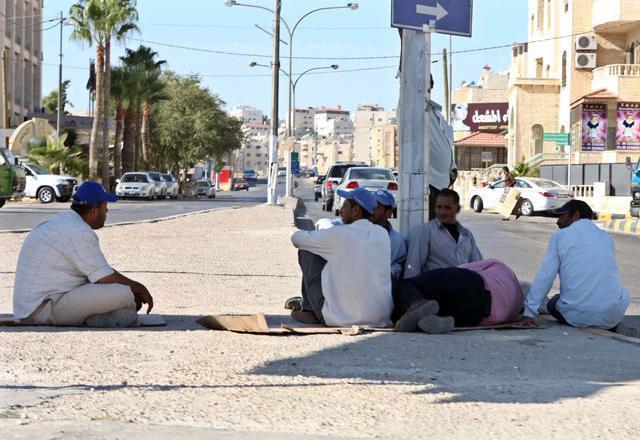You are here
Unemployment rate hit 21.9% in Q1 2023
By JT - May 31,2023 - Last updated at May 31,2023
AMMAN — Jordan's unemployment rate during the first quarter of 2023 stood at 21.9 per cent, marking a decrease of 0.9 per cent compared to the first quarter of 2022 and a decline of 1.0 per cent compared to the fourth quarter of 2022, the Department of Statistics (DoS) announced on Wednesday.
In its quarterly report on unemployment, the DoS said that 19.6 per cent of men were unemployed during the first quarter of 2023 was, compared with 30.7 per cent for women.
These figures were 0.9 per cent for men, and 0.8 per cent for women compared with the first quarter of 2022.
When comparing the unemployment rate for the first quarter of 2023 with the fourth quarter of 2022, both males and females experienced a decrease of 1.0 per cent in unemployment, according to the DoS figures.
The results highlighted that the unemployment rate among university graduates, identified as individuals with a bachelor's degree or higher who are currently unemployed, divided by the labour force with the same educational qualification, reached 25.8 per cent, which was higher than other educational levels.
The statistics department revealed that 54.9 per cent of the total unemployed individuals were high school graduates or higher, while 44.7 per cent had educational qualifications below high school.
The unemployment rate varied according to educational level and gender, with the male unemployment rate for individuals holding a bachelor's degree or higher at 26.7 per cent, against 79.5 per cent for females.
The youth unemployment rate in the age group of 15-24 years was reported at 46.1 per cent for the total population, with 42.1 per cent for males and 64.1 per cent for females.
At the governorate level, the highest unemployment rate was recorded in Balqa, reaching 26.4 per cent, while the lowest unemployment rate was observed in Madaba at 18.3 per cent.
Additionally, the percentage of employed individuals out of the total population aged 15 years and above was 26 per cent.
In terms of age distribution among employed individuals, around 60.5 per cent of males were concentrated in the age group of 20-39 years, while the percentage for females was 60.2 per cent, according to the report.
The report also indicated that 48.6 per cent of employed individuals had educational qualifications below high school, 8.9 per cent had a high school qualification, and 41.8 per cent had qualifications higher than high school.
The results further demonstrated that the majority of employed individuals, accounting for 85.3 per cent, were wage workers, with 83.1 per cent being males and 94.9 per cent being females.
There were disparities in the distribution of the labour force based on educational level and gender. Specifically, 57.5 per cent of the total male labour force had educational levels below high school, while the corresponding percentage for females was 11.0 per cent.
The results highlighted that 71.5 per cent of the female labour force had a bachelor's degree or higher, compared to 26.4 per cent among males.
The adjusted labour force participation rate, which represents the labour force as a percentage of the population aged 15 years and above, reached 33.3 per cent for the first quarter of 2023 (53.3 per cent for males and 13.7 per cent for females), compared to 33.2 per cent for the first quarter of 2022 (53.2 per cent for males and 13.7 per cent for females).
Related Articles
AMMAN — The unemployment rate dropped by 0.6 percentage points in 2024 compared to 2023, reaching 21.4 per cent, according to the annual une
AMMAN — The Kingdom’s unemployment rate went down by 0.8 per cent in the third quarter of 2023, reaching 22.3 per cent, compared with the sa
AMMAN — Jordan's unemployment rate went down by 2.2 per cent in the first quarter of 2022 to 22.8 per cent, compared with the same quarter o

















